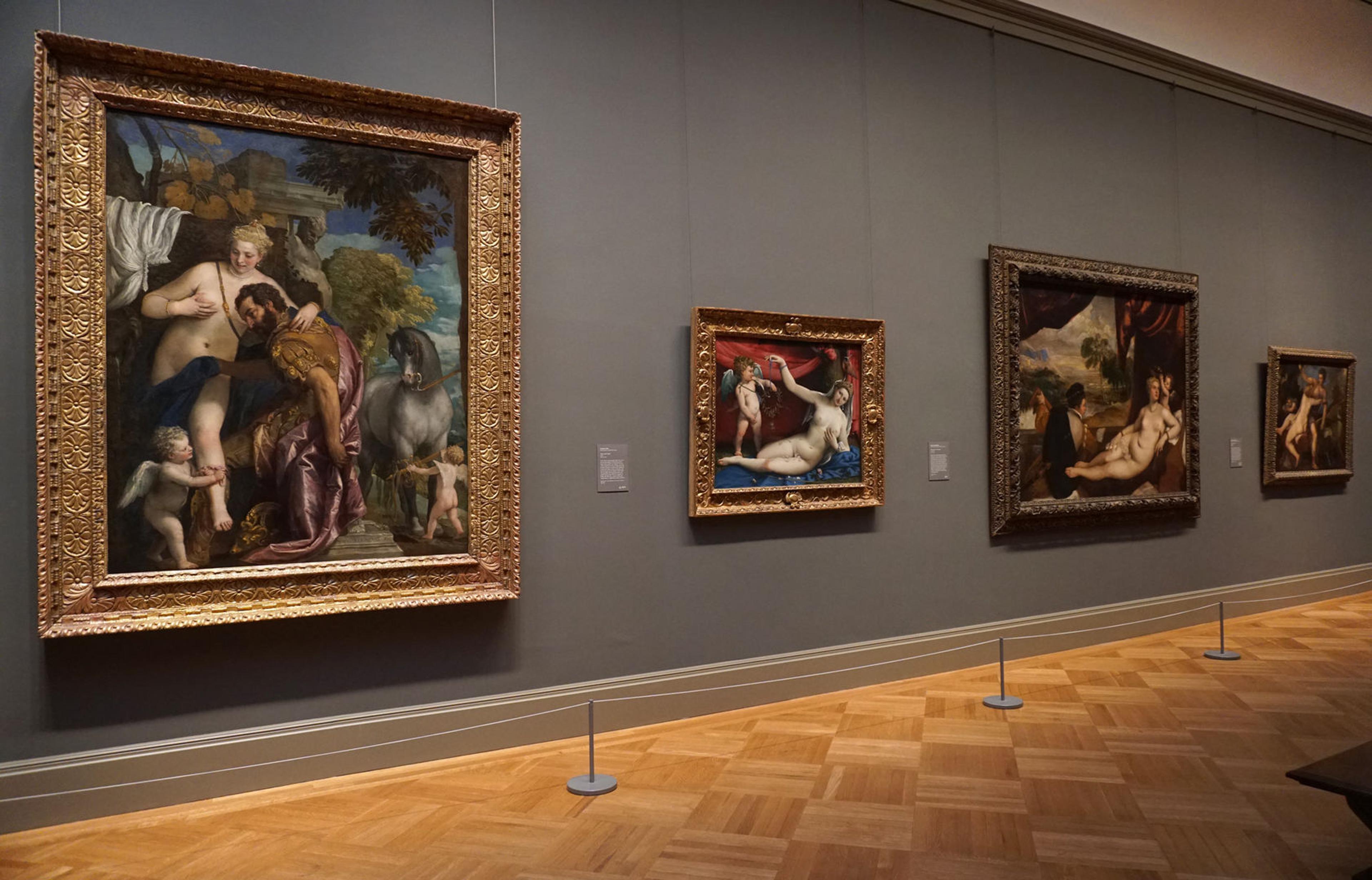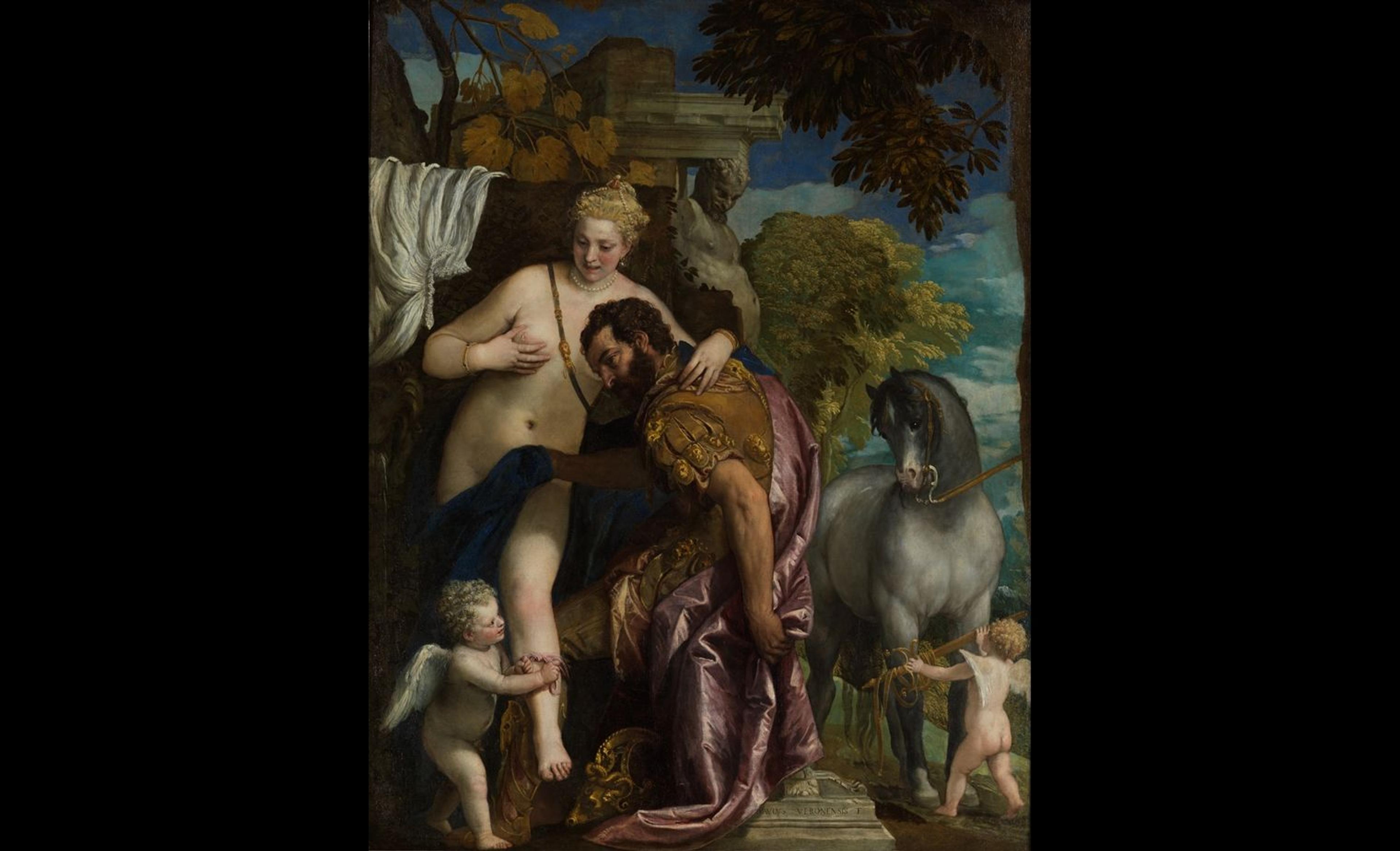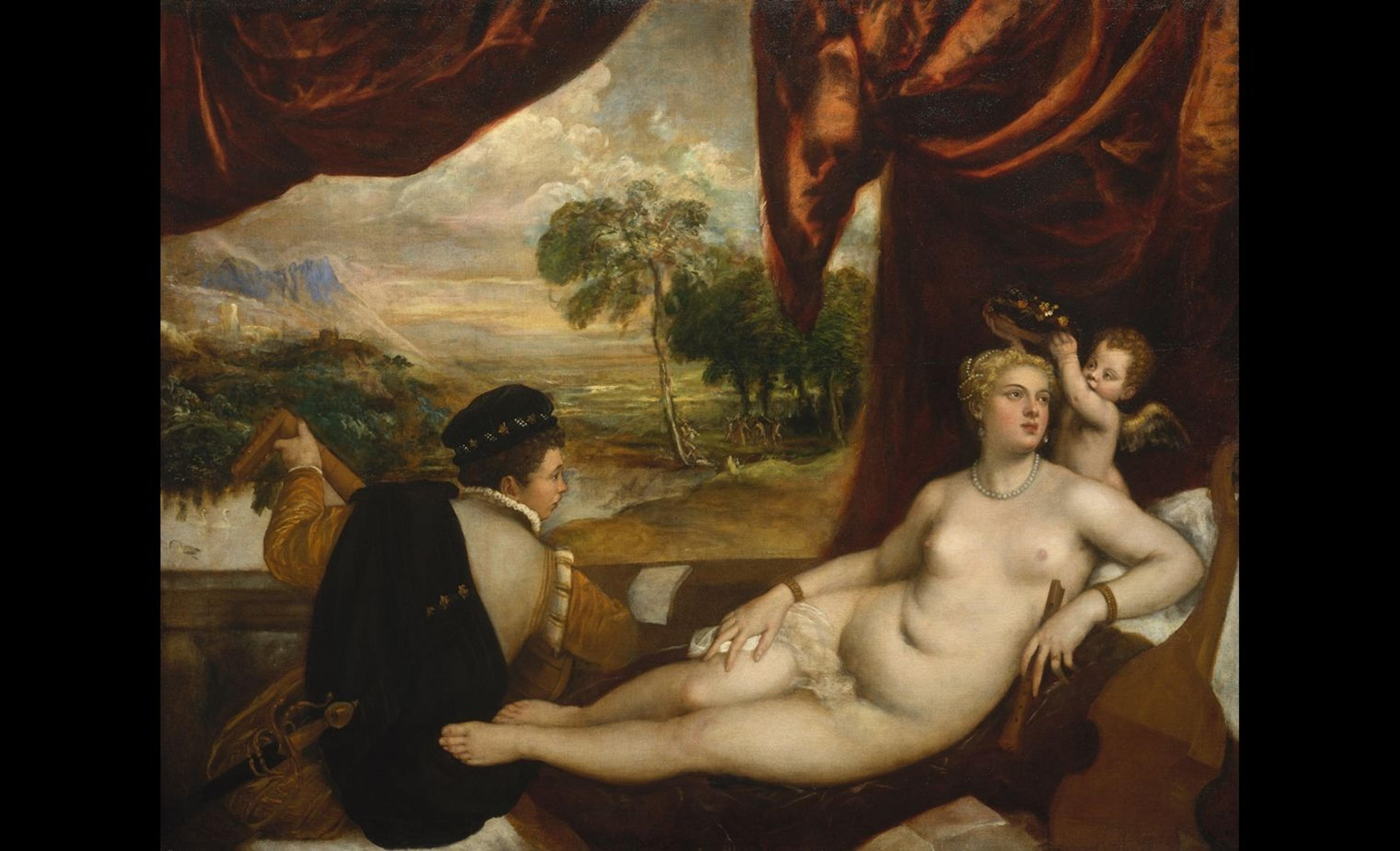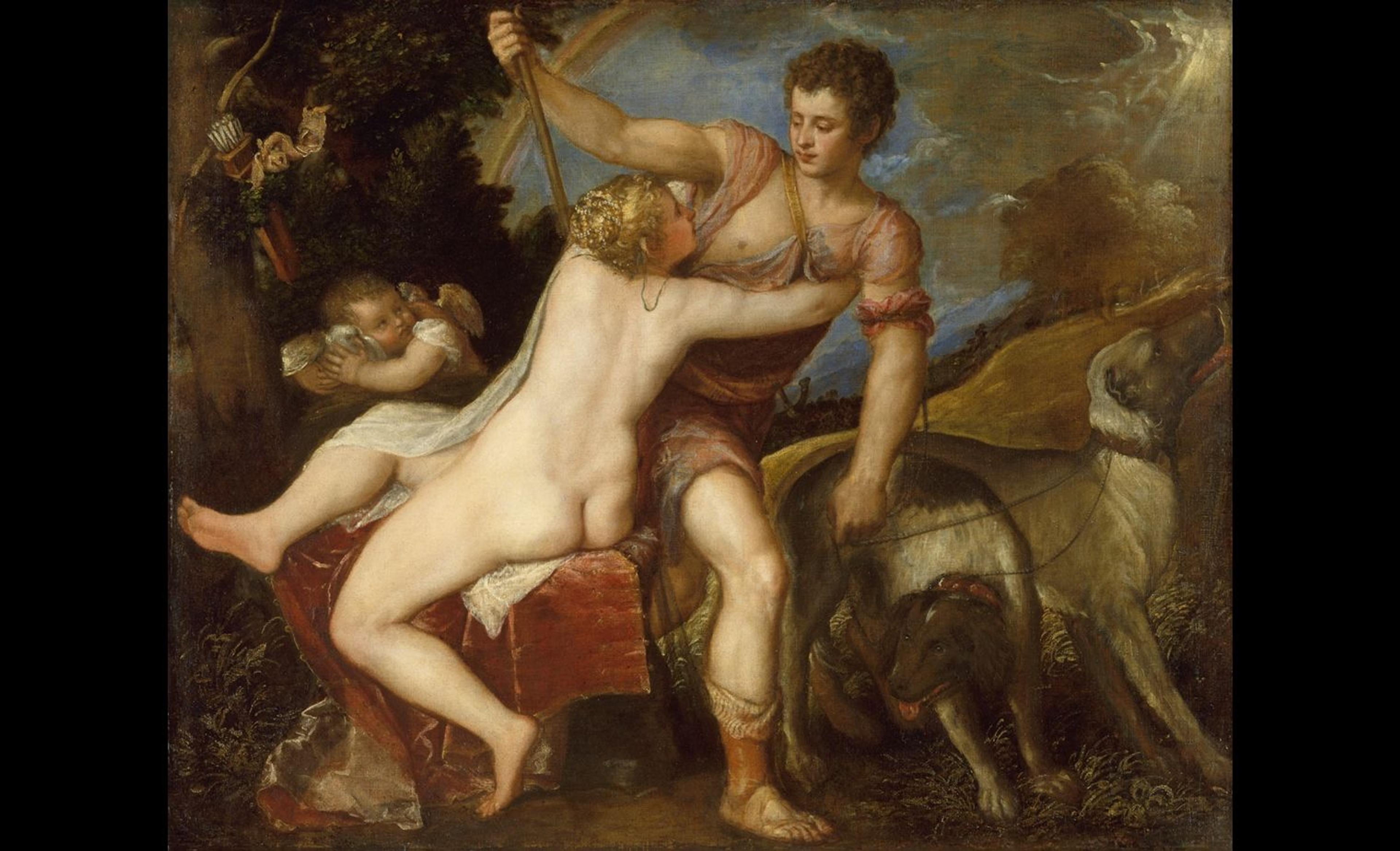"Where did Praxiteles see me naked?" Depictions of Venus in Sixteenth-Century Italian Painting

View of gallery 638 in the Department of European Paintings
For me, one of the most provocative new juxtapositions in the temporary rehang of The Met's Old Master galleries occurs in gallery 638. That's the gallery where, during the first phase of the Skylights Project, the sixteenth-century Italian paintings have been hung, with Florentine pictures on one side and Venetian pictures on the other. What a contrast! The Florentine side is dominated by pictures of the Holy Family and self-possessed male portraits, while on the Venetian side hang four superb pictures featuring Venus, the goddess of love, in which she is depicted splendidly and unashamedly nude. This is the first time we have hung these four canvases in sequence, and the effect provides a real jolt.

Paolo Veronese (Paolo Caliari) (Italian, 1528–1588). Mars and Venus United by Love, 1570s. Oil on canvas, 81 x 63 3/8 in. (205.7 x 161 cm). The Metropolitan Museum of Art, New York, John Stewart Kennedy Fund, 1910 (10.189)
In one—a grand, upright picture by Paolo Veronese—the goddess of love is paired with the warlike Mars, as an envoy of Cupid ties their legs together with a lover's knot. She is naked while he is clothed and wears armor. The message: Harmony born of the union of opposites? Yes, but when Rudolph II, the Holy Roman Emperor, looked at this picture (which he owned together with two others now in the Frick Collection, also by Veronese and also featuring a prominent nude female figure), he most likely also entertained thoughts of a very different and more physical nature.

Titian (Italian, ca. 1485/90?–1576) and Workshop. Venus and the Lute Player, ca. 1565–70. Oil on canvas, 65 x 82 1/2 in. (165.1 x 209.6 cm). The Metropolitan Museum of Art, New York, Munsey Fund, 1936 (36.29)
The fact that paintings of the naked goddess of love—or of the amatory exploits of Jupiter—could also stimulate legitimized erotic pleasure for male (and likely some female) viewers should surprise no one today and was certainly acknowledged at the time they were painted. For example, we happen to know that when Titian created his famous picture of Venus reposing on a bed for the Duke of Urbino (whence its common title as the Venus of Urbino), the appeal of the picture was not its mythological subject but the goddess's nakedness. In his correspondence, the duke refers to the picture not as portraying Venus but simply and suggestively as "quella donna nude"—that naked woman.
The Met's Venus and a Lute Player belongs to a later iteration of the theme that enjoyed enormous success. It shows a musician playing music while he gazes raptly at the goddess's naked body. She holds a recorder, as though to suggest her willingness to join in making music, and Cupid crowns her with a wreath of flowers while in the distant landscape figures dance to a shepherd's piping. An earlier version, in which the musician plays an organ instead of a lute, was sent to Philip II, the King of Spain, who had a private room for Titian's poetically themed paintings featuring a nude female figure. One of these was a painting of Venus and Adonis, a version of which, coincidentally, is also in The Met collection.

Titian (Tiziano Vecellio) (Italian, ca. 1485/90?–1576). Venus and Adonis, 1560s. Oil on canvas, 42 x 52 1/2 in. (106.7 x 133.4 cm). The Metropolitan Museum of Art, New York, The Jules Bache Collection, 1949 (49.7.16)
Titian wrote to the king that in that picture he showed the female from the back so that, when placed in the room with his other paintings, Philip could enjoy the nude female from both the front and the back. This from the king who demanded absolute public conformity in religious matters!
This led me to wonder: Is it possible to create a nude figure—whether male or female; a handsome Saint Sebastian bound to a tree or Eve in the Garden of Eden—that does not have the potential of eliciting erotic thoughts among certain viewers? I doubt it. Indeed, over the course of the sixteenth century churchmen became increasingly concerned about the potential of works of art to elicit uncontrolled responses.
So it is worth reflecting on the fact that in the male-dominated culture of ancient Greece, Venus was traditionally shown clothed, in contrast to the long-standing convention of the naked heroic male. The first depiction of the goddess without clothes occurred in the fourth century BC, when the great sculptor Praxiteles created two cult statues for temples on the island of Kos and Knidus. In one, Venus appeared clothed while in the other the goddess was shown naked, after her bath. Finding the nude goddess indecent, the citizens of Kos purchased the clothed version. Knidus ended up with the rejected statue. It was the nude Venus, however, that quickly became one of the most famous works of art of the ancient world, and turned Knidus into a destination both for devotees of Venus and for art lovers.

Left: Colonna Venus, 2nd century A.D. Roman copy after the Aphrodite of Knidos by Praxiteles, 4th century B.C. Marble, H. 204 cm. Vatican Museums, Pius-Clementine Museum (inv. no. 812). Photo by Ilya Shurygin
Many copies and variants of this celebrated statue exist; the illustration I've chosen is a version in the Vatican (left). The statue was universally admired for its perfection and unearthly beauty, and the story was told that such was its fame that the goddess herself paid a visit. "Where did Praxiteles see me naked?" she was rumored to have exclaimed. Its extraordinary artistic merits notwithstanding, there is no question that Praxiteles's statue also inspired erotic thoughts. Indeed, we're told that one young man, smitten with the statue's beauty, managed to get himself locked in the temple to spend the night with her.

Lorenzo Lotto (Italian, ca. 1480–1556). Venus and Cupid, 1520s. Oil on canvas, 36 3/8 x 43 7/8 in. (92.4 x 111.4 cm). The Metropolitan Museum of Art, New York, Purchase, Mrs. Charles Wrightsman Gift, in honor of Marietta Tree, 1986 (1986.138)
It is only fitting that the fourth picture in gallery 638—by one of the most individual (and certainly among my favorite) painters of the Renaissance, Lorenzo Lotto—shows the nude goddess reclining on a cloth beneath a tree, gazing at the viewer with a delicate smile while her mischievous son, Cupid, mirthfully directs a jet of urine through a myrtle wreath onto her groin—a not-so-subtle allusion to fertility. There is no question that the picture was intended to commemorate a marriage and would have been hung over the nuptial bed. (The face of Venus may be based on that of the bride.) With its plethora of symbolic accoutrements, it celebrates love and marriage by evoking the terms of Classical Roman poetry, but at the same time, it was an inducement to procreation.
Given the cultural, gender, and sexual politics of today, the character, history, and function of these great works by the key figures of Venetian Renaissance painting resonate in directions their creators cannot have imagined, making this gallery a must-see.
Related Content
View the web feature Met Masterpieces in a New Light for more information about the Skylights Project and explore ways to engage with the Department of European Paintings' collection online.
Read more articles in this Collection Insights blog series.
Read essays related to this topic on the Heilbrunn Timeline of Art History: "The Nude in Western Art and Its Beginnings in Antiquity"; "The Nude in the Middle Ages and the Renaissance"; "Art and Love in the Italian Renaissance"; "Venetian Color and Florentine Design."
Keith Christiansen
Keith Christiansen, John Pope-Hennessy Chairman of the Department of European Paintings, began work at the Met in 1977, and during that time he has organized numerous exhibitions ranging in subject from painting in fifteenth-century Siena, Andrea Mantegna, and the Renaissance portrait, to Giambattista Tiepolo, El Greco, Caravaggio, Ribera, and Nicolas Poussin. He has written widely on Italian painting and is the recipient of several awards. Keith has also taught at Columbia University and New York University's Institute of Fine Art. Raised in Seattle, Washington, and Concord, California, he attended the University of California campuses at Santa Cruz and Los Angeles, and received his PhD from Harvard University.